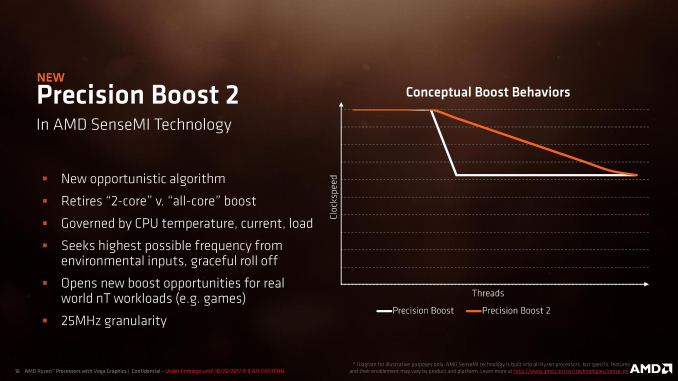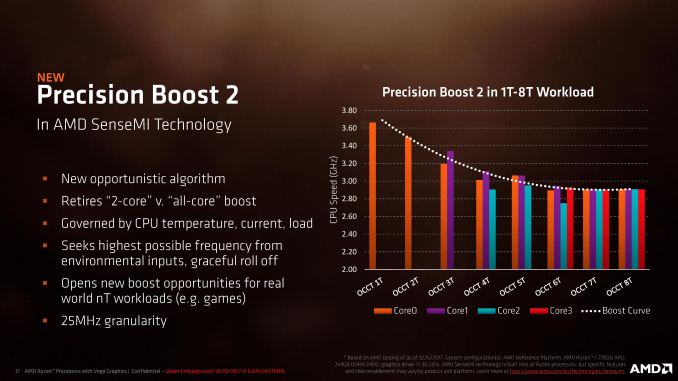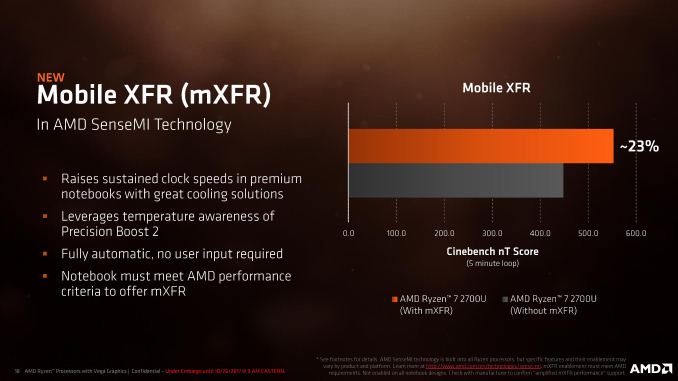Ryzen Mobile is Launched: AMD APUs for Laptops, with Vega and Updated Zen
by Ian Cutress on October 26, 2017 9:00 AM ESTSense Me Ryzen: Better Boost
When AMD launched the desktop Zen processors, it also branded a series of five technologies under the ‘SenseMI’ name. We covered these in detail in our Ryzen 7 review, but in short, it covers the following:
- Pure Power: Sensors to optimize power consumption
- Precision Boost: Determines how Turbo is applied
- Extreme Frequency Range: Going above maximum turbo when possible
- Neural Net Prediction: Using Neural Nets for prefetching data
- Smart Prefetch: Algorithms that work to enhance prefetch
With Ryzen Mobile, the features relating to frequency get an updated model, while Pure Power gets a bigger boost. We’ll cover the power changes on the next page, but it is worth talking about how AMD has improved Precision Boost and brought XFR to laptops.
Precision Boost 2
Most CPU turbo algorithms work by sensing how many cores and threads are under load, determining if the CPU has enough power headroom, and applying a voltage. This is why in the past both of the major x86 CPU manufacturers will quote a ‘per-core turbo frequency’ to show what the frequency should be when different numbers of cores are loaded and all else is fine (there is temperature/power headroom).
For Ryzen Mobile, AMD is pivoting to a new turbo model. When the system is in the P0 (top) turbo state, the system will use a new opportunistic turbo algorithm that rather than being based on the cores under load, is governed by CPU temperatures, currents, and how much load is being applied. The algorithm takes into account all the environmental inputs, such as skin temperature sensors and battery life, and will provide the best turbo frequency it can, regardless of if one thread is being used or all threads are being used.
It will be able to provide boost amounts at the 25 MHz granularity level, similar to how the desktop processors work, with the idea being that in most cases, if the system has a lot of cores available and a background process performs some very light work (such as checking for updates), rather than dropping 500-800 MHz because more cores are loaded, the system will keep at the high frequency.
AMD is stating that this has a big effect on real-world workloads, typically those that have variable thread workloads such as gaming.
When asked if Precision Boost 2 would be coming to the next generation of AMD’s Desktop Ryzen processors, I was told that ‘it could be inferred / it’s a safe bet’.
Mobile Extended Frequency Range (mXFR)
Because mobile systems are thermally limited, battery limited, power limited, and battery limited, offering ‘extra’ turbo headroom is not really something that processor manufacturers like to do. As a result, most of the Ryzen Mobile-powered notebooks will not have any form of XFR – AMD will be allowing it on a case-by-case basis for vendors that overengineer their chassis to be capable of supporting a higher power profile.
This feature essentially extends the average level at which Precision Boost 2 will operate, and also marks what could be considered a higher configurable TDP. One of the systems being launched with Ryzen Mobile this side of Christmas will be mXFR enabled, because the chassis is designed for 25W rather than 15W. It is worth noting that AMD states the configurable TDP of the Ryzen Mobile chips goes up to 25W, so this is likely the case what is happening.
Encode and Decode
AMD is fully using Vega’s encode and decode capabilities with Ryzen Mobile. The big inclusion for AMD’s mobile devices is the ability to decode VP9, the codec prefered in particular by YouTube.
| AMD Ryzen Mobile Encode/Decode Capabilities | |||||
| Decode 1080p @ 4:2:0 |
Decode 2160p @ 4:2:0 |
Encode 1080p |
Encode 1440p |
Encode 2160p |
|
| MPEG2 | 60 FPS | - | |||
| VC1 | 60 FPS | - | |||
| VP9 8/10 bpc | 240 FPS | 60 FPS | |||
| H.264 8 bpc | 240 FPS | 60 FPS | 120 FPS | 60 FPS | 30 FPS |
| H.264 10 bpc | 240 FPS | 60 FPS | |||
| HEVC 8bpc | 240 FPS | 60 FPS | 120 FPS | 60 FPS | 30 FPS |
| HEVC 10 bpc | 240 FPS | 60 FPS | |||
| JPEC 8bpc | 240 FPS | 60 FPS | |||













140 Comments
View All Comments
SaturnusDK - Thursday, October 26, 2017 - link
A few comments"If we look at processors from Intel that are 4C/8T, like the 35W Core i7-7700T, this scores 777 in our testing, which kind of drives away from AMD’s point here."
Not really. You're still comparing a 35W part to a 15W part, so 90% of the performance for 43% the power consumption is still a massive gain. What it really says is the 4T processor, be it with 2C or 4C is truly dead for anything but the lowest tiers. Something Intel have also realized in their current line up.
" In our desktop Ryzen reviews, we saw per-core power go as low as 8W per core, and AMD’s Vega was power hungry"
Vega is really only power hungry when pushed beyond ~1200MHz. Underclock it to that and Vega is extremely power efficient.
smilingcrow - Thursday, October 26, 2017 - link
"Vega is really only power hungry when pushed beyond ~1200MHz. Underclock it to that and Vega is extremely power efficient."This is very relevant for laptops but most desktop users don't seem to care as they want performance rather than efficiency and that is how AMD configure them.
SaturnusDK - Thursday, October 26, 2017 - link
Correct. It's also relevant to miners for example that generally run their GPU at around 1GHz as it's the optimum for power cost vs. performance. However, the article is about mobile CPUs, and in that respect it might have been a good idea to mention that running lower clocks rates drastically lowers the Vega power consumption which is exactly what has been done in these APUs.extide - Friday, October 27, 2017 - link
Yeah, but that 35W part could sustain that performance for a much longer time, if not indefinitely. The 15W AMD part (and likewise 15W Intel parts) will throttle down a fair bit after sustained use. According to AMD the R7 2700U drops to ~550 on cinebench after a 5-min loop. (Last slide on page 3)SaturnusDK - Friday, October 27, 2017 - link
It's possible it could sustain it for longer. We don't know that though. And even 550 points is still a massive performance per watt advantage to the AMD part. 770 points at 35W is 22 points per watt while 550 points (sustained) at 15W is 36.67 points per watt. A whooping 66.7% performance per watt advantage.neblogai - Friday, October 27, 2017 - link
550 points are at 25W, 450 at 15W as said in note regarding AMD slide 19.ruthan - Thursday, October 26, 2017 - link
If could be AMDs TDP value trusted, it could be finally good CPU/GPU for SmachZ or GPD gaming devices.. Present Atoms and AMD solution are very slow for decent mobile gaming..IGTrading - Thursday, October 26, 2017 - link
You cannot compare Intel's Atom with AMD's Carizo.It would be nonsense. Atom is an extremely low performance part that is barely able to equal the gaming performance of a Pentium 4.
Moreover, AMD's TDP values are the ONLY ONES TRUSTWORTHY while Intel was proven to respect the TDP when they feel like it and also they change the TDP definition almost every year.
AMD's Ryzen processors don't step 2% outside their rated TDP no matter the load scenario.
Intel's 8700K and 7980XE can reach a + 16% on their rated TDP.
So I'm inclined to trust AMD's specifications 100% more than Intel's.
t.s - Thursday, October 26, 2017 - link
A good read, Ian! Thanks!Bateluer - Thursday, October 26, 2017 - link
I was very interested in that Lenovo Ideapad 720S model, 13.3in with a 4K screen and the 2700U? Seems like it'd be a nice upgrade from my current Yoga 900 after underwhelming options in 910 and 920. Then I read that was going to stuck in single channel with only PC4-2133. That makes it significantly less attractive.